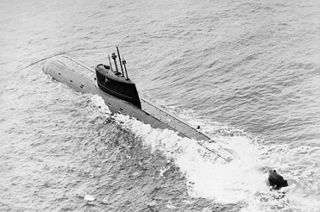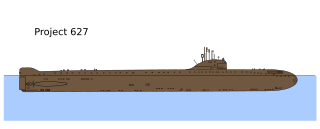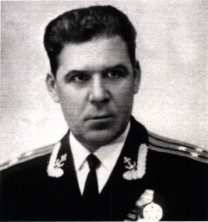
K-141 Kursk was an Oscar II-class nuclear-powered cruise missile submarine of the Russian Navy.

K-219 was a Project 667A Navaga-class ballistic missile submarine of the Soviet Navy. It carried 16 R-27U liquid-fuel missiles powered by UDMH with nitrogen tetroxide (NTO), and equipped with either 32 or 48 nuclear warheads. K-219 was involved in what has become one of the most controversial submarine incidents during the Cold War on Friday 3 October 1986. The 15-year-old vessel, which was on an otherwise routine Cold War nuclear deterrence patrol in the North Atlantic 1,090 kilometres (680 mi) northeast of Bermuda, suffered an explosion and fire in a missile tube. While underway submerged the seal in a missile hatch cover failed, allowing high-pressure seawater to enter the missile tube and owing to the pressure differential rupture the missile fuel tanks, allowing missile's liquid fuel to mix and ultimately combust. Though there was no official announcement, the Soviet Union claimed the leak was caused by a collision with the submarine USS Augusta. Although the Augusta was operating within the area, both the United States Navy and the commander of K-219, Captain Second Rank Igor Britanov, deny that a collision took place.

K-19 was the first submarine of the Project 658 class, the first generation of Soviet nuclear submarines equipped with nuclear ballistic missiles, specifically the R-13 SLBM. The boat was hastily built by the Soviets in response to United States' developments in nuclear submarines as part of the arms race. Before she was launched, 10 civilian workers and a sailor died due to accidents and fires. After K-19 was commissioned, the boat had multiple breakdowns and accidents, several of which threatened to sink the submarine.

The K-278 Komsomolets was the Project-685 Plavnik, nuclear-powered attack submarine of the Soviet Navy; the only submarine of her design class.

The K-159 was a Project 627A "Kit" nuclear-powered submarine that served in the Northern Fleet of the Soviet Navy from 1963–89. Her keel was laid down on 15 August 1962 at the Severodvinsk "Sevmash" Shipyard No. 402. She was launched on 6 June 1963, and commissioned on 9 October 1963.
K-27 was the only nuclear submarine of the Soviet Navy's Project 645. It was constructed by placing a pair of experimental VT-1 nuclear reactors that used a liquid-metal coolant into the modified hull of a Project 627A (November-class) vessel. A unique NATO reporting name was not assigned.
The November class, Soviet designation Project 627 Kit was the Soviet Union's first class of nuclear-powered attack submarines, which were in service from 1958 through 1990. All but one have been disposed of, with the K-3, the first nuclear-powered submarine built for the Soviet Navy, being preserved as a memorial ship in Saint Petersburg.

A nuclear submarine is a submarine powered by a nuclear reactor, but not necessarily nuclear-armed. Nuclear submarines have considerable performance advantages over "conventional" submarines. Nuclear propulsion, being completely independent of air, frees the submarine from the need to surface frequently, as is necessary for conventional submarines. The large amount of power generated by a nuclear reactor allows nuclear submarines to operate at high speed for long periods, and the long interval between refuelings grants a range virtually unlimited, making the only limits on voyage times being imposed by such factors as the need to restock food or other consumables.
K-131 was a Project 675 of the Soviet Navy's Northern Fleet, she was also redesignated K-192.
A nuclear navy, or nuclear-powered navy, refers to the portion of a navy consisting of naval ships powered by nuclear marine propulsion. The concept was revolutionary for naval warfare when first proposed. Prior to nuclear power, submarines were powered by diesel engines and could only submerge through the use of batteries. In order for these submarines to run their diesel engines and charge their batteries they would have to surface or snorkel. The use of nuclear power allowed these submarines to become true submersibles and unlike their conventional counterparts, they became limited only by crew endurance and supplies.

The Echo class were nuclear cruise missile submarines of the Soviet Navy built during the 1960s. Their Soviet designation was Project 659 for the first five vessels, and Project 675 for the following twenty-nine. Their NATO reporting names were Echo I and Echo II. All were decommissioned by 1994.

K-429 was a Project 670-A Скат nuclear submarine of the Soviet Navy. Her keel was laid down on 26 January 1971 at Krasnoye Sormovo in Gorky. She was launched on 22 April 1972, and was commissioned on 31 October 1972 into the Soviet Pacific Fleet.

K-11 was a Soviet November-class nuclear-powered attack submarine that had two reactor accidents during loading of the nuclear reactor core in Severodvinsk on 7 and 12 February 1965. Reasons for the accidents included nonobservance of operating instructions by those participating in the lift of the reactor cover and the mistaken decision to continue refueling after the first accident. There were no fatalities but those accidents caused an unsafe release of radiation into the environment and nearby shipyard area. Seven men were treated for exposure to radiation. The reactor compartment holding the two damaged reactors was removed, partially decontaminated and sunk in Abrosimov Bay in the Kara Sea in 1966. A new reactor compartment was installed and the submarine continued to perform her duties from August 1968 until decommissioning on 19 April 1990. K-11 passed the milestone of 220,179 miles traveled in 1988. The submarine has been laid up in Gremikha Bay since of 2000.
K-431 was a Soviet nuclear-powered submarine that had a reactor accident on 10 August 1985. It was commissioned on 30 September 1965. An explosion occurred during refueling of the submarine at Chazhma Bay, Vladivostok. There were ten fatalities and 49 other people suffered radiation injuries. TIME magazine has identified the accident as one of the world's "worst nuclear disasters".

Nikolai Vladimirovich Zateyev was a Russian submariner and a Captain First Rank in the Soviet Navy, notable as the commander of the ill-fated Soviet submarine K-19 in July 1961 during the Hotel class submarine's nuclear-reactor coolant leak. Zateyev and the actions of his crew managed to avert disaster, despite severe radiation exposure. After the event, Zateyev and his crew were sworn to secrecy by the Soviet government regarding the events that transpired, and were only permitted to reveal the story after its collapse. Zateyev later released his memoirs on the event, which were used as the basis for a number of literary works on the disaster, as well as a 2002 documentary and film. In these memoirs, Zateyev criticised the rushed production of Russia's first nuclear ballistic missile submarine. His and his crew's actions on July 4, 1961, earned the surviving crewmembers a joint nomination for the Nobel Peace Prize in March 2006.

The K-129 was a Project 629A diesel-electric-powered ballistic-missile submarine that served in the Pacific Fleet of the Soviet Navy–one of six Project 629 strategic ballistic-missile submarines assigned to the 15th Submarine Squadron based at Rybachiy Naval Base near Petropavlovsk, commanded by Rear Admiral Rudolf Golosov.
Vsevolod Borisovich Bessonov (1932–1970) was an officer in the Soviet Navy and commanding officer of the K-8– the Project 627 Kit-class submarine. He was honored with the Hero of the Soviet Union. He died during the sinking of K-8.
The decommissioning of Russian nuclear-powered vessels is an issue of major concern to the United States and to the Scandinavian countries near Russia. From 1950 to 2003, the Soviet Union and its major successor state, Russia, constructed the largest nuclear-powered navy in the world, more ships than all other navies combined: 248 submarines, four Kirov-class battlecruisers, and a missile test ship, as well as nine icebreakers. Many were or are powered by two reactors each, bringing the total to 468 reactors. With the end of the Cold War and with its navy chronically underfunded, Russia has decommissioned many of these vessels, and according to one report dated November 2008, intended to scrap all decommissioned submarines by 2012. However, the safety records of the Soviet and Russian navies and the budgetary constraints on the Russian government are matters of great concern. Ships awaiting decommissioning receive little maintenance, and there are insufficient waste storage facilities, raising worries about possible ecological damage from accidents or improper storage.










